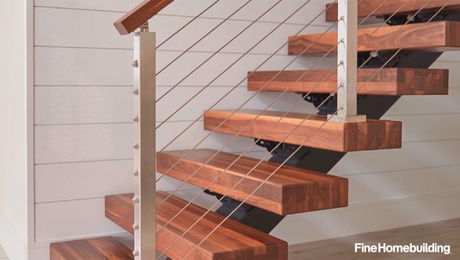I have had a new set of oak stairs installed. The stringers are poplar and will be painted. I do not want to emphasize the grain in the oak.
I have been considering using a grain filler to minimize the grain and give a more finished look, does anyone have experience with grain fillers on stairs? In particular, water based grain fillers.
Also, does anyone have a specific recomendation for a top coat. I am considering leaving the stairs a natural colour (that is no dye or stain – though I am not firm on that.) If possible, I would like to keep to water based finishes with reasonably quick drying times because I am living in the house. I have looked at various polyurethane products, but I don’t know what marketing information to trust.


















Replies
Lacquer based clear polyurethane
Trusting the marketing information on paints, stains, and polyurethane seems problematic. It is all being worked on to comply with new rules. I have had really good results with a polyurethane finish called Fabulon. I understand that polyurethane clear finishes vary in the amount of solids they have in them. I think Fabulon ranks high in solids content. For any application subject to wear, I would use only high gloss product because I have been told that it stands up to wear the best. I also use only oil based product, but you will get many arguments about that.
Fabulon makes two types of oil based polyurethane. One is solvent based, and one is lacquer based. I consider it to be really lucky that the lacquer based product is sill offered. It may not be in every state. Both types have the usual oder issues, but lacquer based sets up really fast. But the realy beauty of lacquer based is that for future re-coating, you don't have to sand the old finish. The new material chemically bites the old finish coat. The lacquer based product was developed for bowling lanes.
With solvent based polyurethane, a new finish can only bond mechanically to the old finish, so you have to sand the old finish.
I am not sure what your oak looks like. I don't like to stain interior wood because it is more work, and I can dispense with the need to change the color by staining. If you put on four coats of Fabulon, you will have an incredibly deep and rich looking finish. I am not sure what to advise on filling the wood pores. I know oak has large open pores, but with a thick coat of polyurethane on them, I don't mind the look. I have used both the lacquer based and the solvent based, and I think I can observe that the lacquer based is longer lasting. It still looks good on my stairs after 15 years of wear, but the wear zone is turned to a flatter finish than the high gloss areas. I might re-do it this summer.
Fabulon may try to discourage you from using the lacquer based product. I have noticed that paint manufacturers and dealers all want to talk me out of using oil based and into using water based. Of course they don't mind if you have to go back and re-do it a couple years later.
You'll get good results with one of the trowel-grade fillers made for filling pores and gaps in hardwood floors - it's waterbased and dries super hard. I use it all the time to fill the grain in oak when making paint-grade items. It's best applied with a wide putty knife and take off all excess - don't think because it goes on easily it will sand easily - it doesn't. Honestly if you don't mind a slight bit of grain you can apply it and after just a few minutes sand it off - it is much easier to sand if it's not completely hard and the look is good under paint - just a very slight oak grain. If you want it completely smooth apply, let is dry completely and sand smooth but don't sand so much that it takes the haze off (the haze means you still have a thin coat over everything).
As for finish, you'll find any of the water based acrylic polyurethanes work well - even the minwax version available at the box stores tested well in durability tests - they all dry quite fast.
The last stairs I finished in a water based finish was with a Parks product from lowes or HomeDepot and I liked it and the results as well as what I'd normally get from my hardwood flooring wholesale supplier.
On thing that works well is painting the risers first with a 100% acrylic paint which allows a light sanding so the finish is nice and flat, then apply the acrylic poly over both the treads and risers - no need to mask off or cut around each riser - the poly is water clear and bonds well with the paint.
If you don't want to put the clear poly over the paint to allow a different sheen, then apply the poly first over everything - no need to avoid the risers, then paint.